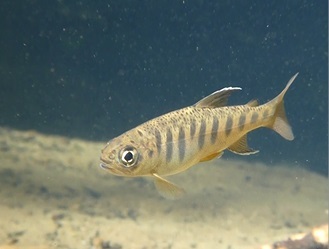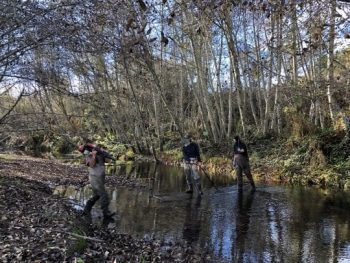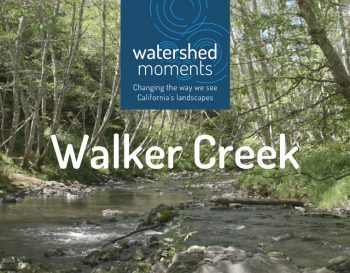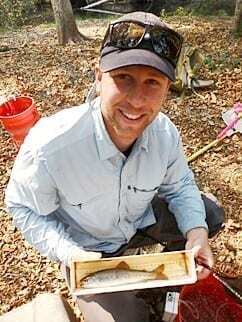Voices of Walker Creek Watershed: Patrick Samuel
by Alisan Theodossiou, CalTrout Senior Communications Manager

Patrick Samuel is the California Trout Bay Area Regional Director.
Walker Creek watershed is only about an hour outside of San Francisco, but it feels very far away, like a completely different world. “This watershed is unique in that it is a rugged, wild landscape right in Marin County and is surrounded by Tomales Bay, making it feel separated from the larger Bay Area,” explains Patrick Samuel, CalTrout’s Bay Area Regional Director. “It’s always been a hard-working watershed too with lots of agricultural operations, including cattle ranching.”
Patrick adds: “What’s interesting about Walker Creek watershed and why it’s important for fish, is that its always open year-round flowing into Tomales Bay. Unlike a lot of coastal streams that become closed off with sand bars, Walker Creek stays open all year, allowing fish access to the watershed even when there’s not enough rain to push open other creek mouths.”
Importance of Walker Creek
Walker Creek has been identified in the federal Coastal Multispecies Recovery Plan by the National Oceanic and Atmospheric Association (NOAA) as a key watershed necessary to recover both coho salmon and steelhead populations along the Central California coast. “For coho salmon and steelhead coming from Walker Creek watershed, they have this nice, soft landing spot in Tomales Bay with a rich feeding area and nursery habitat, so that they can acclimate to sea water there before being exposed to the open ocean,” says Patrick.

Walker Creek juvenile coho salmon. By Derek Acomb, CDFW.
Due to its smaller size and being mostly privately owned without access to the public, “Walker Creek watershed does not receive as much attention and lives somewhat in the shadow of its neighbor, Lagunitas Creek,” Patrick describes. “Walker Creek spills out near the mouth of Tomales Bay near the coast, while Lagunitas flows into the very end of Tomales Bay. This means that every fish that is looking to go into Lagunitas Creek watershed must pass right by the mouth of Walker Creek. Our fish tracking work has shown that Lagunitas Creek fish can and do enter into Walker Creek, and vice versa. Fish from the Russian River have shown up in Walker Creek too. This is important because we need fish moving between habitats – it increases genetic diversity which supports population recovery and spreads out the risk from disease, predators, etc. It’s good to have neighboring watersheds with good habitat so that fish can tuck into different places under changing conditions.”
Walker Creek watershed historically had abundant runs of salmon and steelhead. But due to dam building, nearby mining operations and intense land use practices, those runs have decreased dramatically.
Fish Recovery Actions
To help recover fish and restore the creek, CalTrout and partners UC Davis, California Sea Grant, CDFW, and others have been conducting water quality and temperature monitoring in the watershed and accompanying snorkel surveys to provide data on habitat usage of juvenile coho and steelhead through the summer and fall months when they are most vulnerable to temperature and flow changes. And recently in Fall 2020, CalTrout was approached by the California Department of Fish & Wildlife (CDFW) to assist in tracking tagged adult coho salmon that are annually stocked in Walker Creek by fisheries biologists at the US Army Corps of Engineers Warm Springs Fish Hatchery on the Russian River.

Installing the upstream PIT antenna in Walker Creek in December 2020. Photo by Patrick Samuel.
According to Patrick, “We currently have three Passive Integrated Transponders (PIT) antennas in Walker Creek at downstream, midstream, and upstream locations, thanks to landowners who have generously allowed us access to their land. CDFW recently added a fourth on a key tributary near Soulajule Dam. By having those antennas in place, we can track tagged hatchery adult and juvenile coho salmon to see when and where they are moving in the watershed; they act kind of like gateways. As fish move upstream and downstream, we will be able to identify pockets of good habitat where fish are spending their time growing or rearing, as well as the timing of migrations. The ultimate goal is to increase the monitoring effort on Walker Creek to replicate long-standing programs in neighboring watersheds such as Lagunitas and the Russian River. If we can identify good habitat for fish in Walker Creek, that information can inform restoration efforts for the rest of the creek to improve habitat throughout.”
Additional research and restoration design work is in the works for CalTrout and partners to pursue in the near future. As for Patrick, he is an active supporter of making Walker Creek more of a focal point for coho salmon recovery on the Central California coast. He adds, “Walker Creek watershed is my favorite place to work. It feels so far away but is still right in the Bay Area. There are a lot of demands on this small watershed, and yet, the landscape is supporting commercial agricultural operations as well as endangered species such as freshwater shrimp, coho salmon, and steelhead. The watershed is absolutely beautiful. And I think it has a lot of potential to support and be an impressive demonstration site for some neat restoration and conservation actions.”







